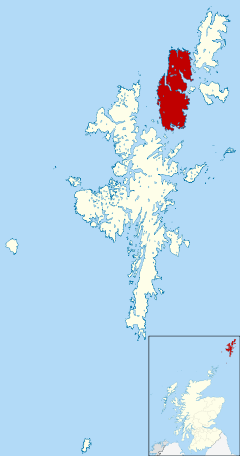Yell: Difference between revisions
| Line 235: | Line 235: | ||
{{NT prop}} | {{NT prop}} | ||
{{Catself}} | |||
Latest revision as of 16:54, 18 April 2019
| Yell | |
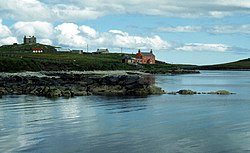 Burravoe, Yell | |
|---|---|
| Main village: | Mid Yell |
| Location | |
| Location: | 60°37’12"N, 1°6’0"W |
| Grid reference: | HU492935 |
| Area: | 82 sq miles |
| Highest point: | Hill of Arisdale, 689 feet |
| Data | |
| Population: | 957 |
Yell is one of the North Isles of Shetland: the most northly inhabited island after Unst. In the 2001 it had a usually resident population of 957.
Yell is the second largest island in Shetland, after the Mainland alone, with an area of 82 square miles,[1][2] and is the third most populous in the archipelago, coming after the Mainland and Whalsay.[1]
Peat covers two thirds of the island to an average depth of 5 feet.
Yell has been inhabited since the Neolithic times, and a dozen broch sites have been identified from the pre-Norse period. Norse rule lasted from the 9th to 14th centuries until Scottish control was asserted.[1] The modern economy of the island is based on crofting, fishing, transport and tourism. The island claims to be the "Otter Capital of Britain" and has a diverse bird life including breeding populations of Great and Arctic Skuas.[3]
Notable buildings on the island include the 17th century Old Haa of Brough in Burravoe, a merchant's house now converted to a museum and visitor centre.[4] There are various folk tales and modern literary references to island life.
Geography
Yell is 19 miles in length, with a maximum breadth of 7½ miles, and is swept all around by very impetuous tides.[5] The island extends northward to within 9 ½ miles of the northwestern extremity of Unst. It is divided by only the narrow Bluemull Sound from the south west of Unst.[5]
On the eastern side the coast is generally low and sandy but there is an extensive rocky and partly precipitous coast on the west that rises slowly to elevations of 200–400 feet.[5] It is indented by seven or eight bays forming natural harbours. As Penrith's guide to Orkney and Shetland states:
The island is roughly rectangular and nearly cut in two where the long voes of Whale Firth and Mid Yell almost meet.".[2]
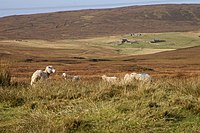

In addition to these large indentations, there are a number of tombolos or ayres connecting peninsulas to the island. Many of these are very fragile, and can be damaged extremely easily by human erosion, or severe storms, creating new islands - or resurrecting old ones.
There is comparatively little farmland, but the coast is conducive to fishing.[5] Much of the interior of Yell is covered in a peat blanket, often as much as 10 feet thick,[6] which is the result of 3,000 years of deposits.[2] The peat retains a great deal of water, but is easily eroded, particularly when it comes near to the coast. As Jill Slee Blackadder writes:
Some streams carve deep sided gorges. Among these habitats, you can find a wealth of wild flowers and birds nest here in peace."[7]
The island was anciently divided into the parishes of North Yell, Mid Yell, and South Yell. More recently the parish of North Yell was merged with that of Fetlar, and Mid Yell and South Yell were amalgamated.[5]
As with the Shetland archipelago as a whole, the island can be seen as creating a barrier between the northern end of the North Sea (to the east) and the North Atlantic (to the west). To the north east is the Norwegian Sea, and the Arctic Ocean is several hundred miles to the north.
Attractions on the island include the Sands of Breckon composed of crushed shells, and the Daal of Lumbister gorge.
Settlements
Settlements on Yell tend to be coastal[6] and include Burravoe, home to the Old Haa Museum, Mid Yell, Cullivoe and Gloup, as well as Ulsta, Gutcher, Aywick, West Yell, Sellafirth, Copister, Camb, Otterswick, and West Sandwick.
There is little in the way of modern settlements on the west coast, other than West Sandwick mainly because of the prevailing wind, and high cliffs that border much of it. There are a few crofts along Whale Firth including Windhouse (see notable buildings), and at Grimister, there are the ruins of an old herring curing station, which closed just after Second World War.[1]
Surrounding islands
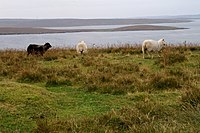
Several islands, islets, skerries and sea stacks surround Yell:
|
|
|
Geology and soils
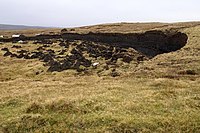
The island's bedrock is largely composed of Moine schist[7] with a north-south grain, a metamorphosed sedimentary rock originally laid down in shallow water 1,000-800 million years ago and then uplifted and deformed during the Caledonian orogeny 600-400 million years ago. The principal minerals are coarse quartzite, quartz-feldspar gneiss[7] and mica schist.
Yell lies to the east of the Walls boundary fault, which is probably a northern extension of the Great Glen Fault. There are three main faults that dictate the geography of Yell - the first is the Bluemull Fault, which separates Yell from Unst by creating the Bluemull Sound; the second is the Arisdale Fault which forms the northern part of Whale Firth, and extends south to Arisdale, and out of Hamnavoe; and the third is the Nesting Fault, which more or less creates Yell Sound, and divides Yell from Mainland Shetland. A fourth fault helps create Gloup Voe, and there are some other minor ones. These faults may be seen as radiating branches of the Walls Fault, and were exacerbated by glacial activity.[7]
Yell was covered in thick ice sheets during the Pleistocene ice ages. Some of the island's gorges, such as the Daal of Lumbister may have originally been created by ancient meltwater streams escaping from underneath retreating glaciers, and it is also thought some of Yell's lochs were originally damned by moraines.[7]
The non-porous nature of the bedrock, the presence of boulder clay and the cool and damp climate have conspired to create large expanses of peat. This covers two thirds of the island with an average depth of 5 feet. Its main constituent materials are sphagnum moss, cotton grass, deer grass, heather and sedge.[8][9] This peat is highly important to the islanders as a fuel source, and in some areas is even worked commercially. It is cut with a tushker (a type of peat spade, akin to the Highland cascrom), and according to Blackadder (2003) "Yell boasts some of the best peat stacking skills in Shetland."[7]
There is also some dune habitat near West Sandwick, something pretty rare in the Shetland Islands; controversially, there has been some commercial extraction of the sand from this area, which may have had a significant environmental impact.[7]
History
Origin of name
There are various possible derivations of the island's name. A Proto-Norse word Jala or Jela may have meant 'white island' referring to the beaches. The Old Norse name though was Gjall signifying 'barren'.[1] The name was also recorded in 1586 as "Yella".[10]
In early modern times, "Yell" was written as "Zell" [5] (which one may liken to the name "Zetland" for Shetland). "Zell" was a mistranscription of "Ȝell", from an initial yogh.
Early history
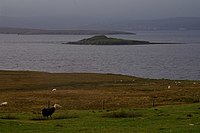
Yell has been inhabited since the Neolithic times.[1] A petrosomatoglyph or stone footprint at North Yell, up Hena, 12 inches by 4 inches is known locally as the 'Wartie' and was used to wash in dew or rain-water and standing in it was supposed to get rid of warts. In legend it was made by a giant placing one foot here and the other on the Westing of Unst.
Twelve broch sites are known of and fifteen early chapels.[1][4] The evidence suggests a substantial population in the Pre-Norse period. One of the brochs is on the peninsula of Burra Ness. Only part of the wall remains, on the seaward side. This reaches around 10 feet high in places. There are traces of earthen ramparts on the landward side, and remains of a structure which may have been a guard's cell. There are also remains of an Iron Age blockhouse fort at Burgi Geos. Burravoe's name derives partly from a nearby broch - the element "Burra" frequently being a corruption of the Norse for one.[7]
Yell's placenames reveal the presence of the Celtic Church, whose hermits were known to the Norse as papar.[7] Examples of names related to them include Papil Ness, Loch of Papil and Papil Bay. However, it is unclear whether these names are all pre-Norse, or whether these Christian co-existed with the pagan Norsemen after they invaded. There is evidence of an early Culdee monastery at the Birrier in the west of Yell, near West Sandwick.[7] The Birrier was almost certainly in contact with another monastic settlement directly opposite, across Yell Sound, at the Kame of Isbister on the Northmavine Peninsula of Mainland.[7] A service was held in 2000, at the Birrier to commemorate two millennia of Christianity.[7]
A cross slab from North Yell may also be from this period, but it has since been lost. It is presumed to be like the Bressay Stone.[7]
Norse era
Yell Sound is mentioned in the Orkneyinga saga:
"Earl Rögnvald... and the chiefs Sölmond and Jón with him... had a fine body of troops, thought not too numerous, and five or six ships. They arrived at Hjaltland [Shetland] about the middle of Summer, but heard nothing of Frákork. Strong and contrary winds sprung up, and they brought their ships to Alasund (Yell Sound), and went a-feasting over the country."[10]
In the later Norse period Christianity flourished and foundations of 20 chapels dating from this period have been identified.[11]
The primary Viking legacy is an abundance of placenames of Old Norse origin. For example, "Dalsetter" is a combination of dalr meaning a "dale" or "valley" and setr meaning a "hill pasture" or shieling. "Gossawater" is a combination of gás (goose), á (river) and vatn (a lake/loch) anglicised as "water".[12] Other common Norse elements on Yell include "firth" (fjörðr) as in Whale Firth, "voe" (vagr) as in "Gloup Voe", "sound" (sund) as in "Bluemull Sound" and "-a(y)" (ey) as in nearby Hascosay and Linga.
Hanseatic trade and early modern period
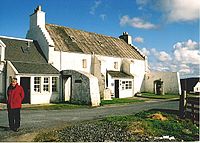
Although most of Shetland's Hanseatic trade was conducted from Scalloway, Burravoe was one of the most important of the other Hanseatic centres in the archipelago.[7]
In the 17th century, the Dutch East Indian Ship, Lastdrager was wrecked on Yell, and the survivor, Jan Camphuis wrote favorably of his experiences on the island. He noted the generosity and kindness of the islanders to him while he was there, which he believed was disproportionate to their poverty.[7] Yell is mentioned by Martin Martin in his 1695 A Description of the Western Islands of Scotland where he noted that "there are three churches, and several small chapels in it."[13][14]
The Rev. Crutwell in the 18th century said of Yell that "the inhabitants have plenty of fuel, catch immense quantities of small fish, and live comfortably."[15]
Modern history
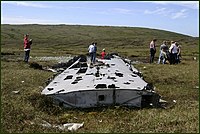
Johnny Notions successfully carried out early smallpox inoculations on Yell in the 18th century, at a time when many other places remained sceptical.[16]
In the 1841 New Statistical Account the minister of Fetlar and North Yell noted that although smuggling had almost entirely disappeared, that the local population had "fallen into an abominable habit of smoking tobacco".[17] In the same year the minister of Mid and South Yell observed a rise of 50% in the local price of black cattle, due to the introduction of a fortnightly steamer service from Lerwick to Leith that had enabled exports of livestock to mainland Scotland.[18] Fishing on Yell received a particularly vicious blow, when 53 fishermen were killed in a storm off Gloup in 1881. There is a memorial to them there now.[6]
Germans have claimed that during First World War, their U-boats used to shelter in Whale Firth – this is possible, because of the very low population of the area.[1]
During Second World War, the Luftwaffe bombed the post office at Gutcher in an attempt to disrupt the communications system.[2] On 19 January 1942, a Catalina flying boat crashed on the hill above Burravoe. Seven of her ten passengers were killed, and one of the propellers can be seen outside the Old Haa Museum.[2]
Just after Second World War, the old herring curing station, at Grimister closed, and this was to be one in a long line of economic difficulties, including the loss of fishing.[1]
In 1961, a Soviet spy ship sank off Yell, and the wreck was found by Lieutenant George Wookey, who had also investigated the wreck that inspired Whisky Galore in the Outer Hebrides.[19] It was an undercover plain clothes mission, and Lt. Wookey found the wreck 90 ft down in clear water.
During the 1960s, Yell reached an impasse. It was in 1965 that the Orcadian novelist Eric Linklater said that Yell was "the problem child of the archipelago" [20] due to its economic woes, and burgeoning depopulation. Some blamed this on the islanders’ "social egalitarianism", which supposedly prevented anyone from becoming a "leader or entrepreneur"; Haswell-Smith disagrees, but believes that "airing the matter seems to have helped”[1] It is certainly notable that the tiny remote Out Skerries seem to be wealthier,[1] and that Whalsay is better at retaining its population. Yell is neither near Lerwick like Bressay, nor bridged to the mainland like Burra or Muckle Roe. Some Yell people do commute to work at Sullom Voe, but as this appears to be a declining industry, this does not hold out hope for the future. However, unlike neighbouring Fetlar, Yell never suffered large scale clearances, only some local ones, and has long had multiple ownership.[1] Jim Crumley, himself an incomer, has noted the difficulties faced by Yell by both depopulation and repopulation.[21]
Birds, beasts and blooms
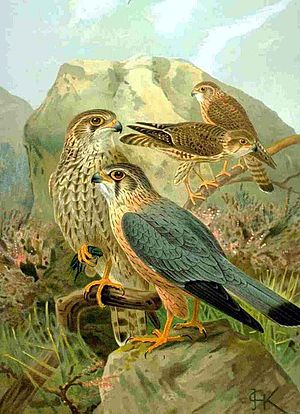
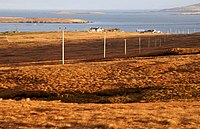
The coastline of Yell includes numerous voes (narrow inlets) where otters and various seabirds are common. Brown trout can be found in the inland waters.[1]
Mammals
Yell claims to be the "Otter Capital of Britain". The shore is low-lying and the peaty soil is soft, making it ideal for excavation burrows. The long days in summer also make spotting these largely nocturnal creatures in daylight more likely than on the British mainland. Hugh Miles's documentary The Track of the Wild Otter was shot on location at Burra Ness at the mouth of Busta Voe; it gained awards and was produced for the BBC. Grey and Common Seals are also regular visitors to Yell's coast.[2][22] Yell occasionally receives the odd Arctic visitor besides the tern; in 1977, a stray Bearded Seal was recorded. Normally these creatures only live on the pack ice.[1] Humans have introduced a number of animals including rabbits, and it has even been questioned whether otters could have arrived by themselves, although this is controversial.[7] Porpoises are occasionally seen nearby too.[7]
The island has its own subspecies of Field Mouse, as do some of the other Shetland Islands, and Hirta in St Kilda.[7]
Birds
A population of Arctic Terns, known locally as Tirricks (stress on last syllable; an onomatopoeic word), migrates to Shetland from Antarctica during the summer. As swallows are sometimes seen as harbingers of summer elsewhere, in Yell and Shetland, it is the Tirricks or terns that fulfil this role -
"On Yell [the Arctic Tern] has the impact of August on a heather moor, and nothing draws the islander closer to nature’s year than the first tern." [21]
Other birds that regularly visit Yell include Great & Arctic Skuas, various terns, Eider, Whimbrel, Red-throated Diver, Dunlin, Golden Plover, Twite, Lapwing and Merlin Falcons.[2] The Eigg, and Ern Stack in the north west of Yell, is the last known nesting site of Shetlandic Sea Eagles, which were recorded there in 1910.[2][23]
Plantlife
Yell has many of the usual plants found in northern European moorland, especially heather in abundance,[7] including two carnivorous plants, the butterwort and the sundew.[2] A substantial study of the flora of Yell's dry stone walls was undertaken in 1986-7. Lichens, especially Ramalina sp., were the most commonly found plants.[24]
The gorges in the island, such as the Daal of Lumbister provide an important environment for some of the few trees on the island, since they are untouched by sheep grazing.[7] Before human colonisation, it appears that Yell was wooded to some degree, at least with dwarf trees and shrubs. In the gorge at the head of Gloup Voe, Dog Roses and Honeysuckle can be found.[7] As the peat preserves old plants and pollen to some degree, due to its anaerobic nature, it is possible to get some sense of the former vegetation of the island. For example, it is known that 40,000 years ago, before the advent of the last Ice Age, and probably any human habitation, that Oak, Scots Pine and Mediterranean heathers were growing here. The remains of these plants have been preserved in layers of ancient peat, which were in turn buried by the boulder clay left by glacial moraines.[7]
Economy
Yell's industries include fishing, fish farming, farming (including commercial strawberry growing in polytunnels,[7] mainly for the Shetland market), peat cutting, transport and tourism.
Cullivoe had a new deep water harbour built in 1991,[4] but the general decline in fish stocks in the North Sea and North Atlantic has not made it useful to fishing. It may however fulfil a transport role.
The "world's first community-owned tidal power generator" is planned for Bluemull Sound. This 30 kW Nova Innovation device is expected to be operational by the end of 2011. North Yell Development Council believe that the project could make a significant contribution to the local economy.[25]
Notable buildings and structures
Built in 1707, the now ruined stone building of Windhouse is claimed as the most haunted house in Shetland. In 1880, when Windhouse was renovated, skeletons were found under the floor of the building.[2] After lying empty for over 80 years, it was bought in 2003 by an English couple who are restoring it.[26]
The Old Haa of Brough in Burravoe is a substantial merchant's house built in 1672 now converted to a museum and visitor centre.[4][27]
At Kirkabister, the remains of a former pony stud can be seen. The enclosure is unusual in appearance, having each of its four corners slightly elevated. There are only a handful of such enclosures in the archipelago.[7]
Folklore
At Breckon it is said that when an eroding grave was excavated, a number of human skeletons were uncovered, one of which was not only at least seven foot tall, but had small stumpy "horns" above the temples.[7] Whether this man was a mutant or this is a tall story is unclear.
Like all good Nordic lands, Yell has its trolls (known in the Northern Isles as "trows" or "trowes"). The Trow of Windhouse was about as recently as the 1880s, when a shipwrecked sailor claimed he had been attacked by the mythical monster. However, the sailor was courageous enough to fight the creature, and saw it off with an axe. It is said that where he killed the trow, the grass turned a light green.[28] This was not the only trow by any means, and there is another story of a Yell woman coming upon a family of trowes, who later woke up to find one in the house, asking who he was, he said "I am Trippa's son". The woman said a prayer, and the trowe disappeared.[29][30]
Literature
George MacKay Brown
George Mackay Brown, an Orcadian poet, wrote a poem which has a Yell-man of 1263 as a narrator.
I am a farmer from Yell in Shetland.
Bjorn my mother called me.[31]
Bjorn grows up amongst "seals and clouds and birds and women" on the island, but this idyll is contrasted with his father's disappearance, and profession as a Viking pirate covered in scars and "harvesting" silver.
Jim Crumley and Among Islands
Jim Crumley is a Dundee man who bought a semi-ruined cottage on Yell.[21] He has written extensively on Yell in the book Among Islands (1994), which contains subject matter ranging from St Kilda and the Hebrides to Shetland. He says his original interest in islands sprung from seeing Inchcape out in the distance, as a teenager. He worked for over twenty years in various newspapers, usually writing about Scottish wildlife and landscapes; his later work has included a number of books on the Scottish islands, and mountains, often including his own photographs.
Crumley has said, "You could never argue with conviction that Yell is a beautiful place",[21] but some others such as Jill Blackadder rate the Sands of Breckon and the cliff scenery of Gloup Voe as some of the best in Shetland.[7] Despite issuing an apparent dismissal, Crumley still has a definite affection for the island, and its almost mechanical role in the Shetlandic whole. In fact, the statement turns out to be a kind of a backhanded compliment:
It looks the way Orkney must have in centuries past before that relentless greening began. The only green on a Yell moor in April is a boggy ooze. Yet Yell is the Shetland I carry with me, the Shetland I pack when I leave, the Shetland I am impatient for when I return. It works because of where it is, an island among islands, a perfectly sealed lynchpin, which makes geographical sense of Shetland, and without which the whole archipelago would slide out of kilter and slither uncontrollably into the sea."[21]
As an incomer himself, he writes on the complications that this has caused the island:
As elsewhere, the island has suffered from depopulation, and has been challenged by repopulation... good intentions do not turn an incomer into a son of the island soil. That is not to say that there is no place for the incomer [though]'.'"[21]
Outside links
| ("Wikimedia Commons" has material about Yell) |
- Shetlopedia.com — Yell
- Listen to recordings of a speaker of Yell Scots
- Haunted house to get makeover
- BBC Island Blogging, Blogs from Yell
- Unst and Yell - National Trust for Scotland
References
- ↑ 1.00 1.01 1.02 1.03 1.04 1.05 1.06 1.07 1.08 1.09 1.10 1.11 1.12 1.13 Haswell-Smith, Hamish (2004). The Scottish Islands. Edinburgh: Canongate. ISBN 1841954543.
- ↑ 2.00 2.01 2.02 2.03 2.04 2.05 2.06 2.07 2.08 2.09 Penrith, James & Deborah (2007) Orkney & Shetland (part of The Scottish Islands series). Richmond. Crimson Publishing.
- ↑ Gooders, J. (1994) Field Guide to the Birds of Britain and Ireland. London. Kingfisher. Pages 147-9
- ↑ 4.0 4.1 4.2 4.3 Keay, J. & Keay, J. (1994) Collins Encyclopaedia of Scotland. London. HarperCollins. Page 991.
- ↑ 5.0 5.1 5.2 5.3 5.4 5.5 Wilson, Rev. John The Gazetteer of Scotland (Edinburgh, 1882) Published by W. & A.K. Johnstone
- ↑ 6.0 6.1 6.2 "Yell feature page". Undiscovered Scotland. http://www.undiscoveredscotland.co.uk/yell/yell/index.html. Retrieved 2008-02-04.
- ↑ 7.00 7.01 7.02 7.03 7.04 7.05 7.06 7.07 7.08 7.09 7.10 7.11 7.12 7.13 7.14 7.15 7.16 7.17 7.18 7.19 7.20 7.21 7.22 7.23 7.24 7.25 Blackadder, Jill Slee Shetland (Colin Baxter Island Guides) (2003) Colin Baxter Photography, Strathspey ISBN 1-84107-125-0
- ↑ Nicolson (1972) pp. 17 and 22.
- ↑ Gillen, Con (2003) Geology and landscapes of Scotland. Harpenden. Terra. Pages 75 and 91.
- ↑ 10.0 10.1 Orkneyinga Saga
- ↑ Nicolson (1972) p. 43.
- ↑ What's in a Name? | ChooseShetland.com
- ↑ A Description of the Western Islands of Scotland by Martin Martin on Undiscovered Scotland: 18. Description of Shetland
- ↑ Martin Martin|Martin, Martin (1695) '"A Brief Description of the Isles of Orkney and Shetland &c." in A Description of The Western Islands of Scotland. Appin Regiment/Appin Historical Society. Retrieved 3 March 2007.
- ↑ Rev Crutwell quoted in Haswell-Smith op-cit
- ↑ Am Baile - Health & welfare
- ↑ Nicolson (1972) pp. 62-3.
- ↑ Nicolson (1972) p. 120.
- ↑ "Lieutenant George Wookey". The Daily Telegraph (London). 2007-04-06. http://www.telegraph.co.uk/news/main.jhtml?view=DETAILS&grid=&xml=/news/2007/04/06/db0601.xml.
- ↑ Eric Linklater quoted in Keay, J. & Keay, J. (1994) Collins Encyclopaedia of Scotland. London. HarperCollins.
- ↑ 21.0 21.1 21.2 21.3 21.4 21.5 Crumley, Jim Among Islands (1994) Mainstream (Edinburgh) ISBN 1-85158-619-9
- ↑ "Yell – Otter Capital of Britain". Visit Shetland. http://www.visitshetland.com/area-guides/yell/. Retrieved 2008-02-04.
- ↑ "Flora and Fauna". Shetland Amenity Trust. http://www.shetland-heritage.co.uk/brochures/area_pages/yell/flora_&_fauna.htm. Retrieved 2008-02-04.
- ↑ Williams, Leslie. "Observations on the Flora of Wall Habitats on Yell, Shetland". From Ecological Studies in the Maritime Approaches to the Shetland Oil Terminal 1986-1987: Report of the Leicester Polytechnic Expeditions to Shetland, August 1986 and July 1987. Edited by J.A. Fowler. The David Attenborough Laboratories, School of Life Sciences, Leicester Polytechnic. (June 1988). Retrieved 20 February 2008.
- ↑ Urquhart, Frank (4 Sept 2011) "Island to switch on power of currents". Edinburgh. Scotland on Sunday.
- ↑ Staples, John (2003-02-10). "Haunted house sold after 80 years". The Scotsman. http://news.scotsman.com/spookystories/Haunted-house-sold-after-80.2401045.jp. Retrieved 2008-02-04.
- ↑ "Old Haa Museum". Shetlopedia. Retrieved 10 February 2008.
- ↑ Windhouse
- ↑ http://www.sacred-texts.com/neu/celt/tfm/tfm061.htm Keightley, Thomas The Fairy Mythology, Illustrative of the Romance and Superstition of Various Countries(1870)
- ↑ Hibbert Description of the Shetland Islands. Edinburgh, 1822
- ↑ Brown, George Mackay The Collected Poems of George Mackay Brown John Murray Publishers
- Nicolson, James R. (1972) Shetland. Newton Abbott. David & Charles.
- The geography section incorporates text from Wilson, Rev. John (1882) The Gazetteer of Scotland Edinburgh. W. & A.K. Johnstone.
| Islands of Shetland |
|---|
|
Inhabited islands: |
